Among the foremost practical (and indeed ethical) concerns of a competent aquarist is the mitigation of stress inflicted upon the animals under his or her care. It has been repeatedly demonstrated that both chronic and acute stress can have a significant impact on animal health. Yet, being that they are not always readily apparent or immediately manifested, these adverse effects are all too often not ascribed to the events (e.g., wrongful handling) that caused them. A truly capable (and indeed conscientious) aquarist can not only take the steps necessary to provide relief to a distressed animal, but can-and should-be able to prevent stressful events from occurring in the first place.
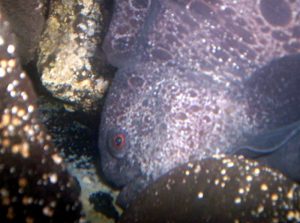
An animal should be thoroughly monitored in the period preceding, and following, its exposure to an anesthetic agent. Photo by Kenneth Wingerter.
Generally, chronic stress prevention requires little more than good planning and common sense (employing adequate shelter, appropriate light levels, sensible stocking density/compatibility, etc.). Acute stress prevention, on the other hand, requires that comparatively exacting measures be taken; here, the proper application of anesthetic agents is an indispensable part of any comprehensive animal health program.
Materials and Methods
1. Assessment
Oftentimes, exposure to MS-222 will itself induce a stress response; therefore, the first (and, arguably, most important) step is to determine that its use in a particular procedure is justifiable (i.e., that the procedure could otherwise inflict undue pain upon the animal and that the animal is fit to fully recover from an anesthetized state).
It will be necessary to ascertain the level of sedation or anesthesia that should be reached; generally speaking, sedation is characterized by disequilibrium and a partial loss of reactivity to stimuli, whereas anesthesia is characterized by incapacitation and a total loss of reactivity to stimuli. There remains some disagreement as to what, if anything, constitutes pain in fishes; generally speaking, pain is here characterized as a pronounced behavioral response (e.g., thrashing or increased opercular movement) and/or physiological response (e.g., altered corticosteroid/catecholamine, lactic acid, or plasma glucose levels) to some injurious/irritating stimulus acting upon the body.
Light sedation (low treatment dose) is most appropriately applied prior to minimal handling (gavage feeding, noninvasive examination, etc.) that will likely not result in significant pain; moderate sedation (moderate treatment dose) is most appropriately applied prior to rougher handling (fin clips, gill biopsies, etc.) that will likely result in low-level pain; anesthesia (high treatment dose) is most appropriately applied prior to heavy handling (internal examination, surgery, etc.) that will likely result in high-level pain, particularly where it may reduce the risk of injury posed by a struggling animal to itself or its keeper; euthanasia (overdose) is most appropriately applied where an animal’s condition has deteriorated such that it is likely suffering from considerable pain, it is unfit to recover fully from a necessary medical procedure, and/or its death is clearly immanent.
If it is determined that MS-222 (or any other anesthetic agent) will be administered, the animal should be purged (i.e., not fed) for 12-24 hours before a (non-emergency) procedure as to reduce the risk of regurgitation.
Ideally, the animal will be repeatedly reassessed until the time of the scheduled procedure.
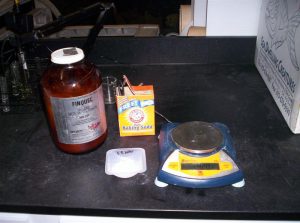
The pH of anesthetic bath water will drop substantially; this must be corrected by the addition of two parts sodium bicarbonate for every one part MS-222 (dry weight) used. Photo by Kenneth Wingerter.
2. Preparation
In some cases, it may help to calm the animal by dimming or cutting the lights over its enclosure on the day of the procedure.
To ensure that the procedure will be carried out quickly, effectively, and safely, one or more keepers should be available to provide assistance as needed.
The work area should be cleaned, organized, and secured in any manner that will facilitate the procedure. Instruments to be used on the animal should be sterilized and readied.
Two baths are drawn (one designated to serve as an anesthetic bath and the other as a recovery bath); water in each container is circulated by way of an air diffuser or some similar device. A transport container may be used to bring the animal to a remote work area. Preferably, all water used in the transport, anesthetic, and recovery baths will be taken directly from the animal’s holding tank.
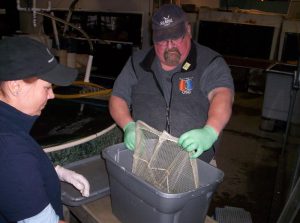
Curator of Animal Husbandry (Hatfield Marine Science Center) Dennis Glaze and Aquarium Science Program student Stacey Nelson capture a wolf-eel (Anarrhichthys ocellatus) prior to performing a fin scrape and gill biopsy. Photo by Kenneth Wingerter.
The required amounts of MS-222 and sodium bicarbonate are each precisely measured in a weigh boat, labeled, and sat aside in a safe area. Just before the animal is extracted from its enclosure, the MS-222 and sodium bicarbonate is stirred into the anesthetic bath water.
The amount of MS-222 needed for a given volume bath can (omitting the full set of conversion factors for sake of simplicity) be expressed as dosage (mg/liter) x volume (liters)/1,000= amount MS-222 (grams). The amount of sodium bicarbonate needed for a given bath can be expressed as amount MS-222 x 2= amount sodium bicarbonate. It should be noted that dosages can vary slightly from those in the generalized recommendations given here (see Table 1) due to a variety of factors (e.g., water hardness/temperature, animal type/size, anticipated duration of procedure); one is advised to review any pertinent special recommendations for certain cases/species.
| Target Treatment Level | Dosage MS-222 (ppm) | Typical Observed Responses |
|---|---|---|
| Light sedation | ~50 | Loss of voluntary movement, markedly decreased responsiveness |
| Moderate sedation | 80-100 | Decreased muscle tone, loss of equilibrium |
| Anesthesia | ~140 | Decreased respiration/heart rates, complete loss of responsiveness |
| Euthanasia | 300-400 | Death |
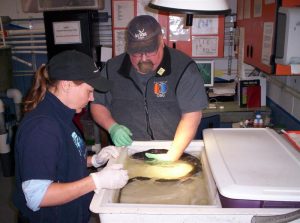
As it is here, the anesthetic bath (to the left) should be close to the recovery bath (covered, to the right); both should be vigorously aerated. Photo by Kenneth Wingerter.
3. Induction and Recovery
The capture, removal, and transport of the animal should be carried out as carefully and quickly as is feasible. Except where dictated by practical necessity (as in the case illustrated by the accompanying image), one should extract the animal by means of a water-filled vessel in preference to a net.
The animal’s condition should be closely and continually monitored from the moment it is placed in the anesthetic bath. Often, the onset of anesthetic induction is marked by an “excitement phase.” Work on the animal can begin when the animal has reached the target level of sedation. If, at any point in the procedure, the animal appears to cease respiring, it must be immediately placed in the recovery bath until it has returned to the target level of sedation. When the procedure has concluded, the animal is placed in the recovery bath for full recovery; it can be returned to its holding tank only when it has regained the ability to swim normally and is totally responsive. Post-anesthetic monitoring should be performed throughout the following 24 hours.
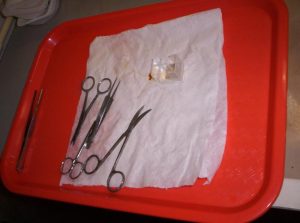
Instruments used on the animal should be easily accessed during the procedure. Photo by Kenneth Wingerter.
Additional comments on the use of MS-222
While reports on the use of everything from clove oil to Alka-Seltzer as materials used to anesthetize fish abound, they have not been proven conclusively to be humane and their use is therefore strongly discouraged. On the other hand, many fully tested/approved anesthetic agents (particularly those developed for use on food fish) are tightly controlled under various forms of legislation, and are consequently rather expensive due to the strict requirements for full licensing.
MS-222 is the only FDA-approved anesthetic for fish. MS-222 has been shown to have a wide margin of safety (i.e., a large difference between effective and lethal doses), and its use is generally accepted by veterinarians as humane.
That notwithstanding, MS-222 should be treated as a hazardous chemical. Protective clothing, gloves, and goggles should be used when handling MS-222 powder. Gloves should be worn while handling animals that have been exposed to MS-222. MS-222 waste should be flushed into a sewer drain with plenty of water, and never disposed of near conveyances to natural (or otherwise untreated) bodies of water. When used in a facility setting, pertinent Material Safety Data Sheets should be readily accessible.
Conclusion
MS-222 continues to be a valuable tool for aquatic animal keepers. Its low cost and wide availability, as well as its relatively high degree of safety and reliability, make it an attractive choice of anesthetic agent for numerous types of applications. Having long proven its efficacy in laboratory, aquaculture, fishery, and veterinary settings, it has begun to show great potential for use with ornamental fish among retailers, small-scale fish breeders and advanced aquarium hobbyists.
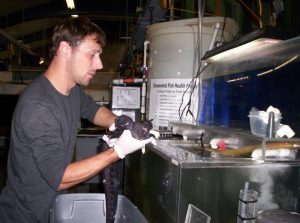
Before it is released back into its holding tank, the animal should clearly be fully recovered from an anesthetized state. Photo by Kenneth Wingerter.
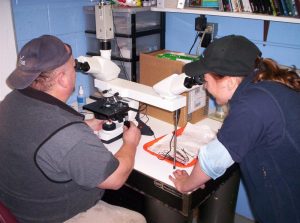
To minimize risk to the animal, the procedure should be carried out as quickly as possible; here, Dennis and Stacey examine tissue and mucus samples obtained during the procedure. Photo by Kenneth Wingerter.
Sources
- Ross, Linda G., BSc, PhD and Barbera Ross, BSc, PhD. Anesthetic and Sedative Techniques for Aquatic Animals. 2nd ed. Malden, MA: Blackwell Science, 1999.
- “Contentious Issues of Experimental Animal Use: Pain in Fish.” Institutional Aquatic Animal User Training Course. US version. Canadian Aquaculture Institute. 26 Oct. 2010: http://www.upei.ca/cai/experimentalfish.htm.
- Gourdon, J. “CARE 110.01 Fish and Aquatic Amphibian Anesthesia.” Cornell Center for Animal Resources and Education, Cornell University, 2003.
- Glaze, Dennis. Personal interview. 22 Oct. 2010.


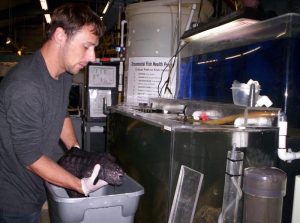

0 Comments